生物专业英语
- 格式:pdf
- 大小:190.45 KB
- 文档页数:12
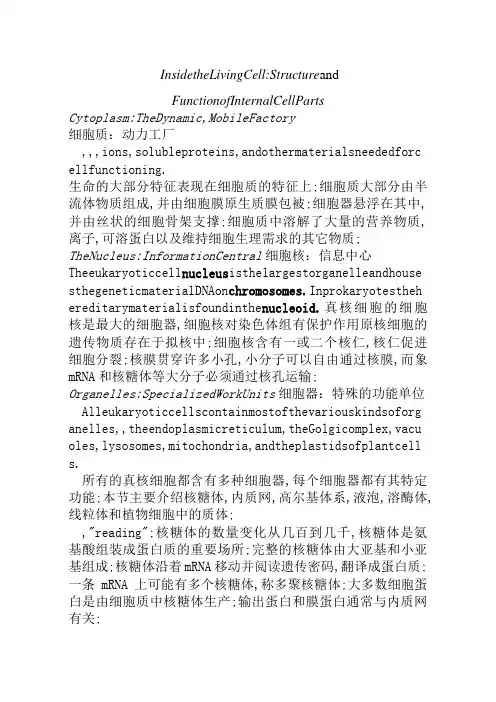
InsidetheLivingCell:Structure andFunctionofInternalCellPartsCytoplasm:TheDynamic,MobileFactory细胞质:动力工厂,,,ions,solubleproteins,andothermaterialsneededforc ellfunctioning.生命的大部分特征表现在细胞质的特征上;细胞质大部分由半流体物质组成,并由细胞膜原生质膜包被;细胞器悬浮在其中,并由丝状的细胞骨架支撑;细胞质中溶解了大量的营养物质,离子,可溶蛋白以及维持细胞生理需求的其它物质; TheNucleus:InformationCentral细胞核:信息中心Theeukaryoticcell nucleus isthelargestorganelleandhouse sthegeneticmaterialDNAon chromosomes.Inprokaryotestheh ereditarymaterialisfoundinthe nucleoid.真核细胞的细胞核是最大的细胞器,细胞核对染色体组有保护作用原核细胞的遗传物质存在于拟核中;细胞核含有一或二个核仁,核仁促进细胞分裂;核膜贯穿许多小孔,小分子可以自由通过核膜,而象mRNA和核糖体等大分子必须通过核孔运输;Organelles:SpecializedWorkUnits细胞器:特殊的功能单位Alleukaryoticcellscontainmostofthevariouskindsoforg anelles,,theendoplasmicreticulum,theGolgicomplex,vacu oles,lysosomes,mitochondria,andtheplastidsofplantcell s.所有的真核细胞都含有多种细胞器,每个细胞器都有其特定功能;本节主要介绍核糖体,内质网,高尔基体系,液泡,溶酶体,线粒体和植物细胞中的质体;,"reading";核糖体的数量变化从几百到几千,核糖体是氨基酸组装成蛋白质的重要场所;完整的核糖体由大亚基和小亚基组成;核糖体沿着mRNA移动并阅读遗传密码,翻译成蛋白质;一条mRNA上可能有多个核糖体,称多聚核糖体;大多数细胞蛋白是由细胞质中核糖体生产;输出蛋白和膜蛋白通常与内质网有关;The endoplasmicreticulum,alacyarrayofmembranoussacs, tubules,andvesicles,maybeeitherroughRERorsmoothSER.,w hichisstuddedwithpolysomes,alsoseemstobethesourceofth enuclearenvelopeafteracelldivides.内质网,带有花边的生物囊,有管状,泡状之分,以及光滑和粗糙面区别;两种都与蛋白质的合成和运输有关;粗糙内质网上分布许多核糖体,也可能提供细胞分裂后所需的细胞膜;SERlackspolysomes;.光滑内质网上无核糖体,主要作用是脂肪和类固醇的合成以及细胞内有毒物质的氧化;两种内质网合成的产物在其中进行分流或运输到细胞外;Transportvesiclesmaycarryexportablemoleculesfromthe endoplasmicreticulumtoanothermembranousorganelle,.运输小泡能够将可运输分子从内质网运输到高尔基复合体上;在高尔基复合体中修饰,包装后输出细胞或传递到细胞质中的其他场所;细胞中的液泡好象是中空的,但实际上充满了液体和可溶分子;最典型的液泡存在于植物细胞中,储备水,糖以及其它分子;动物中的液泡起吞噬和胞饮作用; Asubsetofvacuolesaretheorganellesknownas lysosomes,w hichcontaindigestiveenzymespackagedinlysosomesintheGo lgicomplex.溶酶体是液泡亚单位,含有消化酶,降解大部分生物大分子;消化食物微粒和降解损伤的细胞残片;,线粒体是细胞中化学产能的场所;另外,植物细胞中的质体在光合作用中利用光能产生碳水化合物,线粒体内嵴上提供了很大的表面积并分布着产ATP酶;线粒体自我复制,并且可能是自由生活的原核生物在进化中形成的后代; Therearetwotypesofplastids:leucoplasts,whichlackpigm entsandserveasstoragesitesforstarch,proteins,andoils; andchromoplasts,质体有两种类型:白色体,缺乏色素,是淀粉,蛋白质和油的储备场所;色质体,含有色素;叶绿体是最重要的色质体,含有与光合作用有关的叶绿素;叶绿体的内部结构是由多层膜形成的叶绿体基粒,其中包埋在基质中的基粒称子座;TheCytoskeleton细胞骨架Alleukaryoticcellshaveacytoskeleton,所有的细胞都有细胞骨架,网络结构的纤丝充满了它所能触及的全部空间并且对细胞器提供支持作用;细胞骨架大部分由微丝组成,微丝主要由可收缩的肌动蛋白组成;动植物细胞的许多种类型细胞内运动与肌动蛋白有关;第二类蛋白是肌球蛋白,它与肌肉细胞的收缩有关;细胞骨架的另一个主要结构成分是微管,由球状的微管蛋白组成,象脚手架一般维持细胞的稳定形态;细胞骨架的中间丝提供了细胞质伸缩动力;机械酶,例如,肌球蛋白,动力蛋白,驱动蛋白与微丝,微管相互作用产生动力而引起细胞运动;CellularMovements细胞运动Althoughthecytoskeletonprovidessomestability稳固tocells,itsmicrotubules英maikrutju:bju:l andfilaments丝状物andtheirassociatedproteinsenablecellstomovebycreeping 爬行orgliding滑动.Suchmovementsrequireasolid固体的substratetowhichthecellcanadhere附着andcanbeguidedbythegeometry dimitri几何形状iɡ zibit展览chemotaxis,kemtksis趋药性theabilitytomovetowardorawayfromthesourceofadiffusing 扩散chemical.尽管细胞骨架提供了细胞的某些稳定性,微丝,微管及相关蛋白能使细胞爬行或滑动;这种运动需要固体基质依托并通过表面几何形状的改变而运动;某些细胞具备趋药性,即趋向或逃离扩散开的化学源; Certaineukaryoticcellscanswimfreelyinliquidenvironmen ts,propelledbywhiplike cilia sili纤毛or flagella英fldel 鞭毛.Bothciliaandflagellahavethesameinternalstructure:n inedoubletspairsofmicrotubulesarearrangedinaringandex tendthelengthoftheciliumorflagellum,基体动力蛋白sidearmsthatextendfromoneofthemicrotubulesofeachdoublet成对的东西.某些真核细胞能在液体液体中自由运动,由纤毛或鞭毛推动;纤毛和鞭毛具有同样的内部结构:九个双微管环形排列,纵向延伸,环中心是两个或以上微管组成;纤毛或鞭毛从细胞表面的基体出生长,双微管的动力蛋白臂从一侧延伸到另一侧而引起运动;Nutrients,proteins,maiusin肌凝蛋白proteinsattachedtoorganelles细胞器,小器官pushagainstmicrofilamentsarrayed rei展示集合,收集fromtubutinsubunitsnearorganellescalled centrioles movethechromosomes.大部分植物细胞的营养,蛋白质和其它物质由细胞质流运输;这个过程是由于依附在细胞器上的肌球蛋白反推排列在细胞周围的微丝形成的;绝大部分细胞质运动由微丝和微管完成;在细胞分裂期间,中心粒周围的由微管蛋白亚基装配形成的纺锤体微管移向染色体;Glossarycytoplasm细胞质Thelivingcontentsofacellboundedexternallybytheplasmalemma,in cludinganaqueousgroundsubstance hyaloplasm,cellsap,orcellmatr ix containingorganellesandvariousinclusionsbutexcludingthenuc leusandvisiblevacuoles.cytoskeleton细胞骨架Ofeukaryoticcells,aninternal"skeleton".Itsmicrotubulesandoth ercomponentsstructurallysupportthecell,.nucleus细胞核,核复数nuclei Theorganelleoftheeukaryotecellthatcontainsthechromosomesandh enceultimatelycontrolscellularactivityandinheritancethrought heactivityofthegeneticmaterial,DNAchromosome染色体,.nucleoid拟核,类核,核质体TheDNA-containingareaofaprokaryotecell,analogoustotheeukaryo tenucleusbutnotmembranebounded.nucleoli核仁单数nucleolus Nuclearstructurescomposedofcompletedorpartiallycompletedribo somesandthespecificpartsofchromosomesthatcontaintheinfon-nat ionfortheirconstruction.nuclearenvelope核膜,核被膜Adoublemembranetwolipidbilayersandassociatedproteinsthatisth eoutermostportionofacellnucleus.ribosome核糖体Smallstructurescomposedoftwoproteinandribonucleicacidsubunit sinvolvedintheassemblyofproteinsfromaminoacids.polysome多核糖体Ofproteinsynthesis,severalribosomesalltranslatingthesamemess engerRNAmolecule,oneaftertheother.endoplasmicreticulum内质网Foldedmembranesandtubesthroughouttheeukaryoticcellthatprovid ealargesurfaceuponwhichchemicalactivitiestakeplace. Golgicomplex高尔基复合体Astackofflattened,smooth,membranoussacs;thesiteofsynthesisan dpackagingofcertainmoleculesineukaryoticcells.vacuole液泡Storagecontainerwithinthecytoplasmofacellhavingasurroundingm embrane.phagocytosis吞噬作用Theprocessbywhichthecellwrapsaroundaparticleandengulfsit. pinocytosis胞饮作用Theprocessbywhichacellengulfssomemoleculesdissolvedinwater lysosome溶酶体Aspecializedorganellethatholdsamixtureofhydrolyticenzymes. mitochondrion线粒体复数mitochondria Amembranousorganelleresemblingasmallbagwithalarg erbagresemblingasmallbagwithalargerbaginsidethatisfoldedback onitself;servesasthesiteofaerobiccellularrespiration.plastid质体Anorganellepresentinallplantsexceptbacteria,blue-greenalgae, andfungi;itisenclosedbytwomembranestheenvelopeandhasvariousf unctionschloroplast叶绿体.stroma基质,子座复数stromata Regionwithinachloroplastthathasnochlorophyll.microfilament微丝,纤丝Long,fiberlikestructuresmadeofproteinandfoundincells,oftenin closeassociationwiththemicrotubules;providestructuralsupport andenablemovement.actin肌动蛋白,actininteractswithanotherprotein,myosin,tobringaboutcontrac tion.myosin'maiesin肌球蛋白Aproteinthat,withactin,constitutestheprincipalelementoftheco ntractileapparatusofmuscle.microtubute微管Small,hollowtubesofproteinthatfunctionthroughoutthecytoplasm toprovidestructuralsupportandenablemovement.tubulin微管蛋白Aproteinthatisthemajorconstituentofmicrotubules.dynein动力蛋白,动素Agroupofatleastfourdistinctproteinsfoundintheflagellaandmicr otubulesofeukaryoticcellsandpossessingATPaseactivity. chemotaxis趋化性Alocomotorymovementofanorganismorcellinresponseto,anddirecte dby,andirectionalstimulus.cilia纤毛Numerousshort,hairlikestructuresprojectingfromthecellsurface thatenablelocomotion.flagella鞭毛单数flagellumLong,hairlikestructuresprojectingfromthecellsurfacethatenabl elocomotion.basalbody基体Abodyidenticalinstructuretoacentriole,foundalwaysatthebaseof aciliumoreukaryoteflagellum.centriole中心粒Anorganellelocatedclosetothenucleusinmostanimalandlowerplant cellsbutabsentfromprokaryotesandhigherplants.PhotosynthesisPhotosynthesis occursonlyinthechlorophyllchlorophyll叶绿素-containingcellsofgreenplants,algae藻,andcertainprotists原生生物,,然而cellular细胞的respiration呼吸ishighlyexergonic 吸收能量的andreleasesenergy,photosynthesis光合作用requiresenergyandishighlyendergonic.光合作用只发生在含有叶绿素的绿色植物细胞,海藻,某些原生动物和细菌之中;总体来说,这是一个将光能转化成化学能,并将能量贮存在分子键中,从化学和动能学角度来看,它是细胞呼吸作用的对立面;细胞呼吸作用是高度放能的,光合作用是需要能量并高吸能的过程;,calledthe light-dependentreactions,watermoleculesaresplit 裂开oxidized,02isreleased,在面前,called light-independentreactions,CO2isreducedviatheadditi onofHatoms.光合作用以二氧化碳和水为原材料并经历两步化学反应;第一步,称光反应,水分子分解,氧分子释放,ATP和NADPH形成;此反应需要光能的存在;第二步,称暗反应,二氧化碳被还原成碳水化合物,这步反应依赖电子载体NADPH以及第一步反应产生的ATP;色素forthelightdependentreactionsareembedded深入的内含的inthe thylakoid类囊体membrane膜隔膜ofchloroplasts叶绿体.Thedarkreactionstakeplaceinthestroma.基质两步反应都发生在叶绿体中;光反应需要的大部分酶和色素包埋在叶绿体的类囊体膜上;暗反应发生在基质中; HowLightEnergyReachesPhotosyntheticCells光合细胞如何吸收光能的"excess"excitationenergyistransmittedtoothermoleculesandst oredaschemicalenergy.生物分子能捕获可见光谱中的光能;植物细胞中叶绿素在不同光波下吸收部分吸收光谱;在吸收分子中,光的作用使分子中的电子发生重排;光子的能量激活了分子的能量状态,使其从稳定态进入不稳定的激活态; Allphotosyntheticorganismscontainvariousclassesofchlorophy llsandoneormore carotenoid accessory所有的光合作用生物含有不同等级的叶绿素和一个或多个类胡萝卜素光合作用的辅助色素;称作天线复合体的色素分子群存在于类囊体中;激活色素分子的光能进入叶绿素反应中心,其直接参与光合作用;大部分光反应细胞器拥有两套反应中心,P680和P700,每个光系统都含有一个电子受体和电子供体;这些集合体就是大家熟识的光合系统Ⅰ和光合系统Ⅱ;TheLight-DependentReaction:ConvertingSolarEnergyintoChemical -BondEnergy光反应:光能转化成化学键能Ⅱ.Inthisinitialeventwatermoleculesarecleaved,oxygenisrele ased,光反应的光系统将光能转化成化学复合物ATP和NADPH;当光激活光系统Ⅱ的光反应中心时,通过一系列的氧化还原反应实现能量的传递;反应开始时,水被分解,氧被释放并提供电子;电子首先传递给质体醌,然后通过一系列载体形成的电子传递链;每传递4个电子,形成2个ATP;最后一个受体存在于光反应系统Ⅰ的反应中心里;此处光子激活电子,电子传递给铁氧还蛋白;铁氧还蛋白再氧化,并且辅酶NADP+还原成NADPH;早期产生的ATP和NADPH进入暗反应;;plantsalsoderiveadditionalATPthrough cyclicphotophosphoryl ation,inwhichsomeelectronsareshuntedbackthroughtheelectrontr ansportchainbetweenphotosystemsⅡandⅠ.由电子传递链偶连产生ATP的过程称为光合磷酸化;通过光合系统Ⅱ流经光合系统Ⅰ的电子路径称非循环式光合磷酸化;植物通过循环式光合磷酸化获得额外的ATP,一些电子在光合系统Ⅰ和Ⅱ之间的电子传递链中回流;TheLight-IndependentReactions:BuildingCarbohydrates暗反应:碳水化合物的形成Inthelight-independentreactionsofphotosynthesis,whicharedr ivenbyATPandNADPH,由ATP和NADPH驱动的暗反应中,二氧化碳转化成碳水化合物;即卡尔文循环;二磷酸核酮糖固定二氧化碳,由二磷酸核酮糖羧化酶催化;Oxygen:AnInhibitorofphotosynthesis氧:光合作用的抑制因子Highlevelsofoxygeninplantcellscandisruptphotosynthesisandc analsocause photorespiration-aninefficientfunofthedarkreactio nsinwhich02is fixedratherthanC02andnocarbohydrateisproduced. ReprievefromPhotorespiration:TheC4PathwayMostplantsare C3plants;theyexperiencedecreasedcarbohydratepro ductionunderhot,,however,大部分植物是碳3植物,在高温干旱条件下,由于光呼吸作用而使碳水化合物的合成降低;而在大多数的碳4植物中,由于叶脉的特殊构造和独特的化学路径使植物依然很茂盛;这是碳固定的一个新机制;课后作业:第一篇阅读材料答案:1B,2A,3A,4D,5C,6cGlossarlight-dependentreactions光反应-Thefirststageinphotosynthesis,'senergypasstheener gytohigh-energycarrierssuchasATPorNADPH,whereitisst oredinchemicalbonds.light-independentreactions暗反应Thesecondstageofphotosynthesis,alsocalledtheCalvi n-Bensoncycle,,carbonisfixedandcarbohydratesareform ed.chloroplast叶绿体.absorptionspectrum吸收光谱,吸收谱Thespectrumobtainedwhenradiationlight,ultraviolet radiation,etc.fromasourcegivingacontinuousspectrumi spassedthroughasubstance.Calvin-Bensoncycle卡尔文·本森循环Cyclicreactionsthatarethe"synthesis",RUBP,orsomeo thercompoundtowhichcarbonhasbeenaffixed,.carotenoid类胡萝卜素Light-sensitive,,orange,andyellow.chlorophyll叶绿素Thegreensubstanceofplantsbywhichphotosynthesisisa ccomplished;itisusuallylocalizedinintracellularor ganellescalledchloroplasts. cyclicphotophosphorylation环形光合磷酸化作用Cyclicphotophosphorylationiscoupledtocyclicelectron flow,inwhichATPistheonlyproduct.C3plant三碳植物.C4plant四碳植物Aplantsuchascorninwhichthelightindependentreactio nsofphotosynthesisstarwithafour-carboncompound.noncyclicphotophosphorylation非环形光合磷酸化作用Noncyclicphotophosphorylationiscoupledtononcyclicelectronflow,theelectronsbeingusedtoreduceNADP+aswellastomakeATP.photon光子Aparticlethathaszeromassorchargeandunitspin,thequantumoftheelectromagneticfieldandcarrieroftheelectromagneticforce.photophosphorylation光合磷酸化作用ThesynthesisofATPfromphosphateandADPduringphotosynthesis,usinglightenergy.photorespiration光呼吸Alight-dependenttypeofrespirationthatoccursinmostphotosyntheticplantsanddiffersfromnormalordarkrespiration.photosynthesis光合作用Thesynthesisoforganiccompoundsbyreductionofcarbondioxideusinglightenergyabsorbedbychorophyll.photosystem光合系统;photosystemⅡRUBP核酮糖二磷酸AcompoundwithabackboneoffivecarbonatomsthatisrequiredforcarbonfixationintheCalvin-Bensoncycleofphotosynthesis.thylakoid类囊体Oneofanumberofflattenedfluid-filledsacsthatformthephotosyntheticlamellarsystemofchloroplasts,photosyntheticbacteria,andblue-greenalgae.CellularReproduction:MitosisandMeiosis TheNucleusandChromosomes细胞核是贮藏遗传信息的主要场所;DNA盘绕成螺旋线以及相关的成簇蛋白质;DNA螺旋线缠绕成簇的组蛋白形成珠链状的核小体;这些螺旋和超螺旋形成致密的染色体组结构;每个长链DNA与组蛋白和非组蛋白一起构成染色质物质;Apictorialdisplayofanorganism'schromosomesinthecoiled,,染色体致密的超螺旋状态我们称染色体组;除了性染色体外,大多数细胞的染色体组成对出现,称同源染色体对;非性染色体称常染色体;生物细胞含有两套父母本染色体的称二倍体;含有单套染色体的称单倍体; TheCellCycleThecellcycleisaregularsequenceinwhichthecellgrows,prepar esfordivision,anddividestoformtwodaughtercells,在细胞生长过程中,细胞循环遵循特定程序,分裂准备,分裂成2个子细胞,子细胞再循环;此循环使得单细胞永生;多细胞生物中的许多细胞,包括动物肌肉和神经细胞,要么降低循环速度,要么同时分裂;,theperiodofnormalmetabolism;Sphase,duringwhichnormalsyn thesisofbiologicalmoleculescontinues,DNAisreplicated,andhist onesaresynthesized;andG2,,S,,theperiodofmitosis,,alongwithex ternalstimulatorsandinhibitorssuchas chalones.正常细胞循环由4个时期组成;头三期包括G1,正常新陈代谢;S期,正常新陈代谢同时,DNA复制,组蛋白合成;G2期,短期的新陈代谢和少许生长;G1,S,和G2称分裂间期;最后是M期,有丝分裂期,复制的染色体组浓缩,移动并细胞分裂;据称是染色质控制了细胞循环,伴随外部激活因子和抑制因子如抑素;Mitosis:PartitioningtheHereditaryMaterial前期中期begins,thecondensed浓缩的chromosomesbecomeassociatedwiththe spindle纺锤体.Eventuallythechromosomesbecomearrangedinaplanecalledthe me taphaseplate,during anaphase后期,thetwosisterchromatidsofeachchromosomesplit,末期nuclearenvelopes包膜begintoformaroundeachsetofchromosomes,anddivisionofthecytopl asmtakesplace.生物学家将有丝分裂划分为4个阶段;分裂前期,高度浓缩的两个染色单体通过着丝粒连接在一起;在分裂前期后期和分裂中期前期,浓缩的染色体与纺锤体相连,最后以正确的角度排列在赤道板上;在分裂后期,两个姊妹单体分离,分别拽向细胞两极;在分裂末期,在每套染色体周围形成核膜,细胞质发生分裂;Asmitosisproceeds,thespindlemicrotubulesplayacrucialrolei nensuringthatbothpairedandseparatedchromatids染色单体着丝粒fibers,extendoutwardfromthespindlepolestostructuresonthechr omosomescalledkinetochores着丝粒.Duringanaphasethefibersbegintoshorten,andthechromatidsbe gintomoveapart.在有丝分裂过程中,是纺锤体微管确保了染色单体在适当时间以正确方向进行分离;纺锤体微管由两极向赤道板延伸;在分裂前期,其它微管,着丝粒纤维延伸到染色体的动粒;在分裂后期,纤维开始变短,染色单体分离;中心粒,whileinplantandfungal真菌cellsspindleformationisassociatedwith reions called microtubul eorganizingcenters.植物和动物细胞形成的纺锤体不同;动物细胞与中心粒相连,而在植物和真菌细胞中,纺锤体与微管组织中心的离子相连;Cytokinesis:PartitioningtheCytoplasm胞质分裂:细胞质分离Thedivisionofthecellcytoplasmattheendofmitosisiscalled cy tokinesis细胞浆移动.Inanimalcellsittakesplaceasaringofactinfilamentscontracts 使缩短合同契约aroundthecellequator赤道,pinching收聚,whicharebounded有限制的byacellwall,存放堆积intheregionofthecellplate.在动物细胞中,环形肌动蛋白丝延赤道板收缩而使细胞一分为二;在植物细胞中,在赤道板形成新的细胞板;Meiosis:TheBasisofSexualReproductionMeiosis减数isaspecialformofcelldivisionthattakesplaceinthereproductive 生殖,ittakesplaceafterDNAreplicationhasoccurredandinvolvestwos equential连续的nucleardivisionsmeiosisIandmeiosisⅡ.Thesedivisionsresultinf ourdaughtercells,因此,thehomologous同源的chromosomesdistributed分布todifferentprogeny后裔cellsarenotidentical同样的.减数分裂是性细胞分裂的特殊形式;如有丝分裂,它也是发生在DNA 复制后并有连续的两个核分裂;产生4个子细胞,分别含有亲本一半的染色体数;同源chromosomesundergo经历sy-napsis联会,orpairing,whichisbroughtaboutbyabridgingstructureofprotei nsandRNAcalledthe synaptonemal联会丝的排列onthemetaphase 中,however,duringanaphaseIthetwochromatidsofeachchromosomest ayjoinedatthecentromere着丝点减半的ofthechromosomenumberinthefourdaughtercellsthatresultfrommei osis.正如在有丝分裂中一样,两个同源染色单体通过蛋白质和RNA桥配对形成联会复合体;与有丝分裂不同的是,每组染色体的两个染色单体连接在着丝点上并一起移向细胞两极的一级;由此而导致4个子细胞染色体数减半;Duringtelophase末期Inuclearenvelopesenclosethechromosomesinnuclei,andinmostspec iescytokinesis细胞浆流动thefirstnucleardivisionⅡ,inwhichthechromosomesineachdaughte rcellagainalign排列着丝粒finallydivide,,.第二次核分裂开始于分裂中期,子细胞中染色体重新排列在赤道板上;着丝粒最终分离,每个姊妹染色单体分向两极;接着胞质分裂;产生4个单倍体,父母染色体随机分配; AsexualVersusSexualReproductionMitosisandmeiosis,respectively分别,遗传无性的reproductiontheparentorganism生物体givesrisetooffspring后代'ssuccessfulgeneticcomplement遗传互补,requireslittleornospecializationofreproductiveorgans,灾难的机制"new"geneformstoariseandspreadthroughpopulations.有丝分裂和减数分裂在传递遗传信息过程中各有优势;体细胞的繁殖就是父母本的克隆,其优势是保留了父母本的成功遗传信息,不需要特殊器官,比性复制快的多;但一个简单灾难性事件或疾病都可能摧毁一个细胞群体;性复制的优势是它提供了遗传可变性和现存排除有害突变的机制;也可以产生新的基因并在种群中蔓延;课后作业:第一篇阅读材料答案:1C,2B,3D,4B,5A,6DGlossarymitosis有丝分裂Processthatresultsinequalandidenticaldistributionofrepli catedchromosomesintotwonewlyformednuclei.meiosis减数分裂Theprocessbywhichanucleusdividesintofourdaughternuclei,eachc ontaininghalfthenumberofchromosomesoftheparentnucleus. histone组蛋白Oneofagroupofsimpleproteinsthathaveahighcontentofthebasi caminoacidsarginineorlysineandarefoundassociatedwithnucleica cidsinthechromatinofeukaryoticcells.nucleosome核小体,togetherwithabout140basepairsofDNAcoiledaroundit. chromatin染色质,mostoftheproteinbeinghistone.karyotype核型,染色体组型, Theappearanceofthechromosomecomplementofanorganismorcell. homologouspair同源染色体对二倍体Anynucleus,cell,ororganismthatpossessestwicethehaploidnumber ofchromosomes.haploid单倍体Anynucleus,cell,ororganismthatpossessesasinglesetofunpairedc hromosomes,interphasecycle分裂间期周期Inacellpreparingtoduplicate,theinterphasestagecandividedinto aperiodofinitialgrowthG1,aperiodofDNAsynthesisS,andasecondgr owthperiodG2.chalone抑素Substancesfoundinmammaliantissuehomogenatesthat,whenapplie dtointacttissuecells,inhibitmitosis,particularlyinthepresenc eofadrenalineandcorticosteroids.prophase分裂前期Firststageofmitosis,duringwhichindividualchromosomesbeco mevisible.chromatid染色单体Areplicatedchromosomephysicallyattachedtoanidenticalchrom atidatthecentromere.centromere着丝粒Thesmallareaofachromosomethatdoesnotstainwithbasicdyesduri ngmitosisandmeiosis;atinterphaseitissinglewhiletherestofthec hromosomeismadeupoftwochromatids.metaphase分裂中期Secondstageinmitosis,duringwhichthechromosomesalignattheequa torialplane.spindle纺锤体Anarrayofmicrotubutesextendingfrompoletopoleandusedinthe movementofchromosomes.metaphaseplate赤道板,中期板Thegroupingofthechromosomesinaplaneattheequatorofthespin dleduringthemetaphasestageofmitosis.anaphase分裂后期Thethirdstageofmitosis,duringwhichthecentromeressplitandth echromosomesmovetothepoles.telophase分裂末期Laststageinmitosisduringwhichdaughternucleiareformed.cytokinesis胞质分裂Divisionofthecytoplasmofonecellintotwonewcells.cellplate细胞板Aplantcellstructurethatbeginstoforminthecenterofthecelland proceedstothecellmembrane,resultingincytokinesis.FoundationsofGenetics EarlyTheoriesofinheritaneeEarlyideasofinheritanceincludedHippocrates',:theyheldthath eritabletraitsofthetwoparentsblend,sothatthedistinctcharacte risticsofeacharelostinoffspring.遗传学的早期理论包括泛生说和种质理论;基于小鼠实验,维丝曼提出遗传信息储存在配子中并将遗传信息传递给后代;这两个早期观点合起来形成融合理论:子代拥有父母本混合的遗传特征,而不完全象亲代;GregorMendelandtheBirthofGeneticsGregorMendel,anAugustinianmonkinthemonasteryatBrunn,Austri a,isknownasthe"fatherofgenetics."Havingbeenexposedtotheories oftheparticulatenatureofmatterwhileauniversitystudentandhavi ngabackgroundinmathematics,.孟德尔,众所周知的遗传学之父,是一名修道士;当他还是大学生时就提出了物质的粒子属性;孟德尔进行了一系列周密安排的实验来证实遗传的颗粒性;直到他去世后,他的理论才被理解和接受;Mendel'sClassicExperimentsMendelstudiedgeneticsthroughplant-breedingexperimentswitht hegardenpea,aplantspeciesthatisself-fertilizingandbreedstrue eachoffspringisidenticaltotheparentinthetraitofinterest.Tote sttheblendingtheory,,suchasseedcolorandplantheight,presenton lytwo,,andfollowedtheresultsofeachcrossfortwogenerations.孟德尔通过豌豆实验研究遗传学,豌豆是自花授粉植物和纯品系;为验证融合理论,他的研究主要集中在7个特征上;例如,种子颜色,植株高度,这些特征只有两个明确的可能性;他记录了产生的每一个子代类型和数量,在杂交产生子2代;Foreachofthecharactershestudied,F2generation,theratioofdom inanttorecessivewas3:,,—itsphysicalappearanceandproperties-differsfromits genotype,.对于每个特征而言,要么显形,要么隐性;在子2代中显形与隐性比为3∶1;只有在每个个体仅拥有两个研究遗传单元,并每个单元来自一个亲代时,实验结果才成立;此遗传单元就是今天共识的等位基因;两个一样的等位基因决定一个特征,称纯合;相反,称杂合;当生物是杂合时,它的表型由显性基因决定;因此,生物的表型与基因型是不同的;旁纳特方格可以陈列所有可能的遗传组合;TheresultsofMendel'sexperimentsondominantandrecessiveinherit ancelettoMendel'sfirstlaw:分离定律,生物只遗传父母本等位基因对的一个等位基因;减数分裂期形成配子时两个等位基因分离;为验证此理论,他做了测交实验,即基因型未知的植物与纯合的隐性基因植物杂交;子代显性表型可以明确测得杂合基因或纯合基因的基因型; Mendel'sIdeasandtheLawofindependentAssortmentMendelalsoperformed dihybridcrosses,,'slawsis incompletedomi nance,,.双因子杂合试验,两个特征是如何相互影响遗传的;试验结果产生独自分配定律,即等位基因独立遗传;特例是,不完全显性;子代的表型是父母本的中间类型;不完全显性说明了两个等位基因对表型都有影响;,等位基因会继续分离;,.1866年,孟德尔在自然史上发表了他的科学论文,陈诉了他的观点;不幸的是,他的研究不被当时科学家接受;在1900年,他的着作再被发现利用;ChromosomesandMendelianGeneticsSoonafterMendel'sworkwasrediscovered,,',inwhichachromosome pairfailstosegregateduringmeiosis.孟德尔着作被再发现不久,WalterSutton和TheodorBoveri提出,遗传单位可能定位在染色体组上;伴性遗传又导致了不分离现象的发现,即在减数分裂中,染色体对不分离;课后作业:第一篇阅读材料答案:1C,2C,3A,4A,5B,6BGlossarypangenesis泛生论,泛生说Thetheoryofhereditypostulatingthatgerms,humours,oressence smigratefromindividualbodycellstothesexorgansandcontributeto thegametes.germplasmtheory种质学说Asubstancethoughttobetransmittedinthegametesgermcells. dominant显性Thememberofapairofallelesthatshowsitseffectinthephenotypew hateverotheralleleispresent.recessive隐形的Thememberofapairofallelesthatdoesnotshowitseffectinthepres enceofanyotherallelicpartner.allele等位基因Alternativeformsofageneforaparticularcharacteristic.,attac hedearlobegenesandfreeearlobegenesarealternativeallelesfor earshape.gene基因AunitofhereditylocatedonachromosomeandcomposedasequenceofDN Anucleotides.homozygous纯合的Adiploidorganismthathastwoidenticalallelesforparticularchara cteristic.heterozygous杂合的基因型Thecatalogofgenesofanorganism,whetherornotthesegenesareexp ressed.phenotype表型Thephysical,chemical,andpsychologicalexpressionofgenesposs essedbyanorganism.Punnettsquare旁纳特方格Amethodusedtodeterminetheprobabilitiesofcombinationinazygo te.lawofsegregation分裂定律Whengametesareformedbyadiploidorganism,theallelesthatcontr olatraitseparatefromoneanotherintodifferentgametes,retaining theirindividuality.testcross测交Acrossbetweenaheterozygoteofunknowngenotypeandanindividua lhomozygousfortherecessivegenesinquestion.dihybridcross双因子杂种,双因子杂合子独立分配定律,自由组合定律Membersofonegenepairwillseparatefromeachotherindependentl yofthemembersofothergenepairs.incompletedominance不完全显性Theconditioninwhichtwoallelicgeneshaveadifferenteffectwhe ntheyaretogetherasaheterozygoteinadiploidcellthaneitherofthe mhaveinthehomozygousstatenondisjunction不分离Thefailureofseparationofpairedchromosomesatmetaphase,.Discoveringthe Chemical NatureoftheGene GenesCodeforParticularProteinsThefirstscientisttoinvestigatethequestionofhowgenesaffectphe notypewasSirArchibaldGarrod,是第一个研究基因是如何影响表型的科学家,他对尿黑酸症的研究揭示了基因与酶之间的关系;Beadle和Ephrussi在三十年后对果蝇眼睛颜色的研究发现特殊基因与相关反应的生物合成有关;接着对面包发霉粗糙脉孢菌的突变试验得出一个基因一个酶的假说;他们的工作为其他工作者铺平了道路,即精确地阐明了酶影响了复杂的新陈代谢途径;在1949年,对镰刀状细胞贫血症的研究对一个基因一个酶的假说进一步上升为一个基因一个多肽; TheSearchfortheChemistryandMolecularStructureofnucleicAcids Nucleiacid,originallyisolatedbyJohannMiescherin1871,',MacL eod,在1871年,核酸最初是由JohannMiescher分离成功,并由Feulgen在1900年证实核酸是染色体组最基本的组成;FrederickGriffith对粗糙和光滑的肺炎球菌实验表明,不确定的某种物质可以从一组细菌转移到另一种细菌中;在1940年,确认该物质为DNA;四个碱基和磷酸分子分别连接在糖分子上,称核苷酸;DisagreementoverwhetherDNAcouldcarrycomplexgeneticinformat ionwasendedintheearly1950sbyMarthaChaseandAlfredHershey,,and notprotein,isthebearerofgeneticinformation.直到1950年,通过对大肠杆菌实验发现,遗传物质是DNA,而不是蛋白质;EachDNAnucleotidecontainsafive-carbonsugar,deoxyribose,att achedtooneoffourbases:adenine,guanine,cytosine,,每个核苷酸都含有一个五碳脱氧核糖,分别连接4个碱基,即:腺嘌呤,鸟嘌呤,胞嘧啶,胸腺嘧啶;碱基连接糖称核苷;磷酸键形成磷酸骨架;Chargaff’srulesdescribethefactthat1theamountofadenineiseq ualtotheamountofthymineinDNA,withamountofcytosineequaltothat ofguanine,and2theratiosofAtoTandofCtoGvarywithdifferentspeci es.1腺嘌呤与胸腺嘧啶,胞嘧啶与鸟嘌呤相等;2腺嘌呤与胸腺嘧啶,胞嘧啶与鸟嘌呤的比例随物种不同而不同; TheResearchRacefortheMolecularStructureofDNAInthelate1940sandearly1950s,researcherslookingforthestruct ureofDNAdrewuponChargaffsinsight,Levene'sideasonDNAcomponent s,,andtheotherwas X-raydiffraction photosofDNA,showingahelicalstructurewithdistancebetweenthecoils,takenbyFranklinandWilki ns.直到40年代末50年代初,研究者在寻求DNA结构过程中,确立了Chargaff的观点和,Levene的组成理论以及其他两个线索;一个是LinusPauling的假设,DNA可能具有螺旋结构,通过氢键连接;另一个是X-衍射图片,FranklinandWilkins提供;,whichalwaysoccurasA-TorG-C,.基于这些信息,Watson和Crick提出了双螺旋结构模型,成对的核苷酸通过氢键相连,遗传信息就贮藏在碱基对中; HowDNAReplicatesIntheirmodelofDNAstructureandfunction,WatsonandCrickhypoth esizedthatDNAreplicatesitselfby"unzipping",DNA进行复制是以拉链方式自我复制,产生的两个二分体分别为模板生成互补链,即半保留复制;并由Meselson和Stahl验证;'to3'directionfromthe5'carbonofonesugartothe3'carbonofthen ext.Theleadingstrandissynthesizedcontinuously,.intwodirectionsatoncefromhundredsorthousandsofpointsoforig in.大肠杆菌复制开始时形成泡样复制叉,链生长方向由5′向3′端,前导链连续生成,后随链由冈崎片段组成,由DNA聚合酶催化;真核生物复制与原核生物复制相似,但有几百到几千个复制原点原核一般只有一个复制原点;课后作业:第一篇阅读材料答案:1C,2C,3B,4A,5D,6D,7BGlossaryone-gene-one-enzymehypothesis一基因一酶假说,thishypothesishasbeenreplacedbytheone-gene-onepolypeptidehy pothesis.one-gene-one-polypeptidehypothesis一基因一多肽假说.adenine腺嘌呤Apurinebasethatisanessentialconstituentofthenucleicacidsanda lsoofsuchcoenzymesasNADandFAD.guanine鸟嘌呤.cytosine胞嘧啶.thymine胸腺嘧啶.purine嘌呤,whichareconstituentsofnucleicacidsandcoenzymes.pyrimidine嘧啶Aheterocyclicorganiccompound,.nucleoside核苷:cytidine,cytosinedeoxyriboside,thymidine,uridine,adenosine, adeninedeoxyriboside,guanosine,,uridine,adenosine,andguanosi neareribosides.X-raydiffractionX射线衍射,includingsomeimportantmacromolecules,.,DNA,haemoglobin,myog lobin.DNAdoublehelix双螺旋Thethree-dimensionalstructureofdoublestrandedDNA. semiconservativereplication半保留复制ThemethodofreplicationofDNAinwhichthemoleculedivideslongitud inally,eachhalfbeingconservedandactingasatemplatefortheforma tionofanewstrand.replicationfork复制叉ApointatwhichthetwostrandsofaDNAdoublehelixareunwoundandsepa ratedduringreplication.Okazakifragment冈琦片断AshortsequenceofDNAthatistheprimaryproductofDNApolymerasedur ingDNAreplication.polymerase DNA聚合酶AnenzymethatbringsnewDNAtriphosphatenucleotidesintopositionf orbondingonanotherDNAmolecule.The Originand DiversityofLife AHomeforLife:FormationoftheSolarSystemandPlanetEarthThestoryoflife',inturn,;theplanets,includingtheearth,'ssi ze,temperature,composition,.生命起源于地球的形成;大爆炸是我们行星形成的开始;太阳在50亿年前生成,位于太阳系中心,行星,包括地球,在46亿年前生成;地球由多层组成:坚硬的地壳,半流体的地幔,一个很大的溶解中心中存在一个坚实的中心;地球的基本特征使生命起源成为可能,包括行星的大小,温度,组成以及离太阳的距离;当前主要假设认为,由非生命的化学物质进化过程自发产生了生命;TheEmergenceoflife:OrganicandBiologicalMoleculesonaPrimitiv ePlanet,includingthepioneeringworkofMillerandUrey,havesuccessful lyproducedorganicmonomersincludingaminoacids,simplesugars,通过创造出地球早期的自然条件和化学资源条件,科学家在实验室中已经获得了化学有机体生命前阶段的证据;这些实验包括米勒等早期所做工作,成功地产出了有机单体,包括氨基酸,单糖,核酸碱基;这些单体自发的连接成多聚体,如类蛋白和核酸,使进入生命状态成为可能;这些聚合作用可能发生在泥土或岩石表面;Researchershavefoundthat,whenenergyisavailabletoasystem,,当一个系统获得能量时,可能发生3种有机分子的聚集;从多聚物的溶液中俄国科学家获得了富含小液滴的多聚物,即凝聚物;从氨基酸和水的混合液中Fox获得了类蛋白微球体;实验室第三个结构物质是脂质体,即由磷脂形成的球形脂双层结构;,whichcanformspontaneouslyunderconditionsmimickingthoseof theearlyearth,可能是地球早期形成的第一个贮藏信息的物质;在实验室模拟早期地球自然条件下其可自发形成;核酶的发现说明它可以催化早期核酸形成新的RNA;对于RNA物种而言,某些催化RNA具备类似于性交换的功能;Followingthedevelopmentofalipid-proteinsurfacelayerandrep licatingRNAandDNAinformationalmolecules,theeventsleadingtot heemergenceoflivingcellswouldhaveincludedtheoriginofthegene ticcode;thesequesteringofRNAorDNAintocell-likestructures;an dthedevelopmentofmetabolicpathways.接下来脂蛋白表层的形成,RNA的复制,DNA信息分子的形成,最终导致活细胞的出现,包括最初的遗传密码,RNA或DNA被包裹进细胞样的结构中;及代谢途径的建立;TheEarliestCells',,,.能说明活细胞存在的最古老化石大约有35亿年了;最早出现的细胞可能是厌氧异氧生物,自养生物很久后出现;最早的自养生物自己生产营养并释放氧气,这个新陈代谢副产品对后期生命的形成有一个深远的影响;臭氧层的出现减少了紫外线的渗透;结果,细胞就能够在浅水区和陆地上生存了;大气中氧气数量的增加使得需氧细胞进化并产生细胞呼吸,这预示着全球碳循环的开始;最早期的细胞都是原核生物,直到15亿年后,真核细胞才出现; TheChangingFaceofplanetEarthChangesinlandmasses,theseas,,solidcrustoverahot,semisolidm antleandaninner,';'sorbitandintheoutputofenergybythesun.大陆板快,海洋的改变,以及气候对地球生命的进化都有深远影响;地幔上大板快地壳的挤压形成大陆漂移;大陆漂移雕塑了地壳的外观,使现在大陆形成;伴随板块运动,气候改变对活有机体有深远影响;在特定时期的生物大量灭亡高峰是这个时期的见证;生物也受冰河期影响,在冰河期,地球轨道和太阳能的输出都发生了很大变化;Taxonomy:CategorizingtheVarietyoflivingThings生物学家利用林奈发展的双名法对生物分类;系统选定每个类型的生物进入属和种,然后将生物进一步分类更高级类别中,即科,目,纲,门,界;来自于生物化学和比较解剖学等亚生物学领域的证据有助于划分物种和更高级的分类单位,然而物种最初依据形态学特征进行分类的,今天生物学家大体上使用孤立多产的群体作为标准;.分类学揭示了物种间进化的大量关系;进化枝中的成员来自一个共同的祖先;TheFiveKingdoms:organismsaregroupedintothekingdomsMonera,Protista,Fungi,P lantae,,thekingdomsareprobablynotrueclades.进化系统树是进化关系的图解表现;教材中使用一个通用的5界:,,真菌,植物,动物;尽管这个系统是一个便利的组织工具,5界划分可能不是正确的进化枝;课后作业:第一篇阅读材料答案:1B,2A,3B,4C,5A,6CGlossaryBigBang大爆炸地壳。
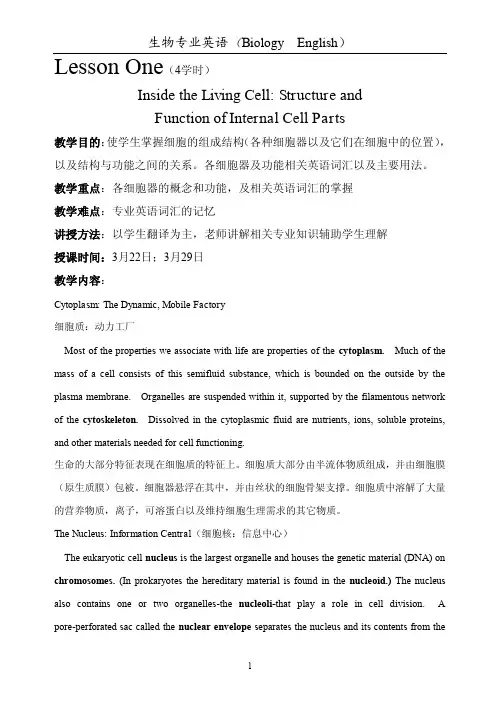
Lesson One(4学时)Inside the Living Cell: Structure andFunction of Internal Cell Parts教学目的:使学生掌握细胞的组成结构(各种细胞器以及它们在细胞中的位置),以及结构与功能之间的关系。
各细胞器及功能相关英语词汇以及主要用法。
教学重点:各细胞器的概念和功能,及相关英语词汇的掌握教学难点:专业英语词汇的记忆讲授方法:以学生翻译为主,老师讲解相关专业知识辅助学生理解授课时间:3月22日;3月29日教学内容:Cytoplasm: The Dynamic, Mobile Factory细胞质:动力工厂Most of the properties we associate with life are properties of the cytoplasm. Much of the mass of a cell consists of this semifluid substance, which is bounded on the outside by the plasma membrane. Organelles are suspended within it, supported by the filamentous network of the cytoskeleton. Dissolved in the cytoplasmic fluid are nutrients, ions, soluble proteins, and other materials needed for cell functioning.生命的大部分特征表现在细胞质的特征上。
细胞质大部分由半流体物质组成,并由细胞膜(原生质膜)包被。
细胞器悬浮在其中,并由丝状的细胞骨架支撑。
细胞质中溶解了大量的营养物质,离子,可溶蛋白以及维持细胞生理需求的其它物质。
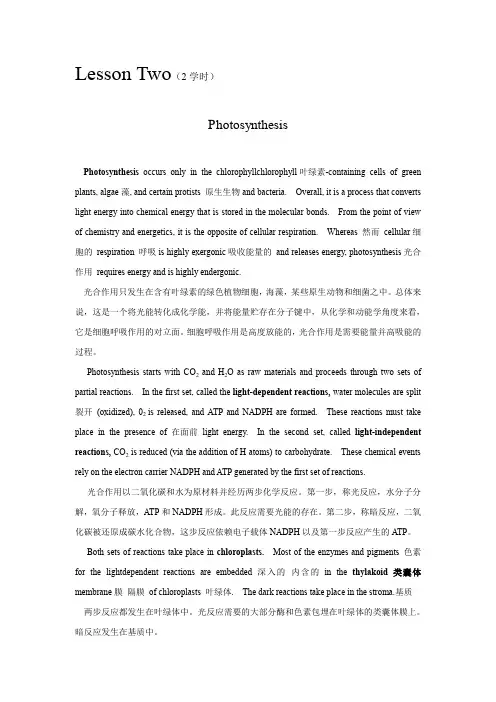
Lesson Two(2学时)PhotosynthesisPhotosynthesis occurs only in the chlorophyllchlorophyll叶绿素-containing cells of green plants, algae藻, and certain protists 原生生物and bacteria. Overall, it is a process that converts light energy into chemical energy that is stored in the molecular bonds. From the point of view of chemistry and energetics, it is the opposite of cellular respiration. Whereas 然而cellular细胞的respiration 呼吸is highly exergonic吸收能量的and releases energy, photosynthesis光合作用requires energy and is highly endergonic.光合作用只发生在含有叶绿素的绿色植物细胞,海藻,某些原生动物和细菌之中。
总体来说,这是一个将光能转化成化学能,并将能量贮存在分子键中,从化学和动能学角度来看,它是细胞呼吸作用的对立面。
细胞呼吸作用是高度放能的,光合作用是需要能量并高吸能的过程。
Photosynthesis starts with CO2and H2O as raw materials and proceeds through two sets of partial reactions. In the first set, called the light-dependent reactions, water molecules are split 裂开(oxidized), 02 is released, and ATP and NADPH are formed. These reactions must take place in the presence of 在面前light energy. In the second set, called light-independent reactions, CO2 is reduced (via the addition of H atoms) to carbohydrate. These chemical events rely on the electron carrier NADPH and ATP generated by the first set of reactions.光合作用以二氧化碳和水为原材料并经历两步化学反应。
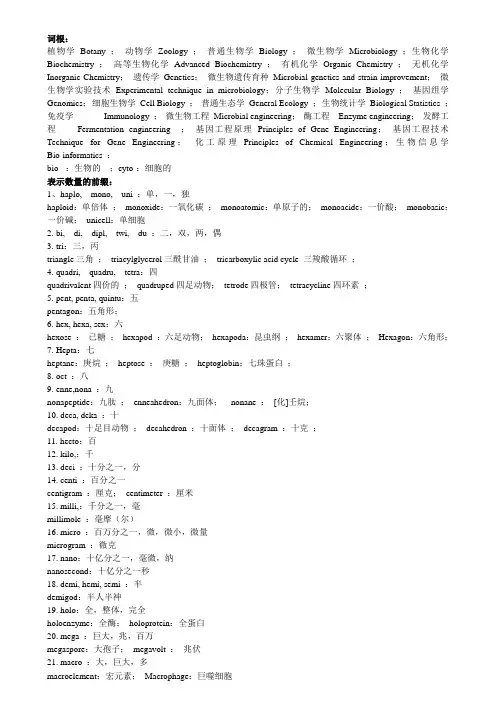
词根:植物学Botany ;动物学Zoology ;普通生物学Biology ;微生物学Microbiology ;生物化学Biochemistry ;高等生物化学Advanced Biochemistry ;有机化学Organic Chemistry ;无机化学Inorganic Chemistry;遗传学Genetics;微生物遗传育种Microbial genetics and strain improvement;微生物学实验技术Experimental technique in microbiology;分子生物学Molecular Biology ;基因组学Genomics;细胞生物学Cell Biology ;普通生态学General Ecology ;生物统计学Biological Statistics ;免疫学Immunology ;微生物工程Microbial engineering;酶工程Enzyme engineering;发酵工程Fermentation engineering ;基因工程原理Principles of Gene Engineering;基因工程技术Technique for Gene Engineering;化工原理Principles of Chemical Engineering;生物信息学Bio-informatics ;bio- :生物的;cyto-:细胞的表示数量的前缀:1、haplo, mono, uni :单,一,独haploid:单倍体;monoxide:一氧化碳;monoatomic:单原子的;monoacide:一价酸;monobasic:一价碱;unicell:单细胞2. bi, di, dipl, twi, du :二,双,两,偶3. tri:三,丙triangle三角;triacylglycerol三酰甘油;tricarboxylic acid cycle 三羧酸循环;4. quadri, quadru, tetra:四quadrivalent四价的;quadruped四足动物;tetrode四极管;tetracycline四环素;5. pent, penta, quintu:五pentagon:五角形;6. hex, hexa, sex:六hexose :已糖;hexapod :六足动物;hexapoda:昆虫纲;hexamer:六聚体;Hexagon:六角形;7. Hepta:七heptane:庚烷;heptose :庚糖;heptoglobin:七珠蛋白;8. oct :八9. enne,nona :九nonapeptide:九肽;enneahedron:九面体;nonane :[化]壬烷;10. deca, deka :十decapod:十足目动物;decahedron :十面体;decagram :十克;11. hecto:百12. kilo,:千13. deci :十分之一,分14. centi :百分之一centigram :厘克;centimeter :厘米15. milli,:千分之一,毫millimole :毫摩(尔)16. micro :百万分之一,微,微小,微量microgram :微克17. nano:十亿分之一,毫微,纳nanosecond:十亿分之一秒18. demi, hemi, semi :半demigod:半人半神19. holo:全,整体,完全holoenzyme:全酶;holoprotein:全蛋白20. mega :巨大,兆,百万megaspore:大孢子;megavolt :兆伏21. macro :大,巨大,多macroelement:宏元素;Macrophage:巨噬细胞22poly,multi :多,复合表示颜色的词:1 、chrom:颜色chromosome:染色体;chromatography:色谱法;chromoplast:[植]有色体;2、melan, melano:黑melanoma:黑素瘤;melanian:黑色的,黑色素的;melancholia:精神抑郁症;3 、erythro:红erythrocyte :红细胞;erythromycin :红霉素;erythrophyll:叶红素;4 、chloro, chlor:绿,氯chlorophyll:叶绿素;chloroplast:叶绿体;chloride:氯化物;chloromycin:氯霉素;5、cyan, cyano:蓝,青紫色,氰cyanobacteria:蓝细菌;cyanide:氰化物;cyanomycin:青霉素;6 leu, leuc, leuk,:无色,白色leucine:亮氨酸;leukaemia=leucosis:白血病;leucocyte:白细胞;表示方位和程度的词:1 endo :内,在内endocrine:内分泌;endocytosis:细胞内吞作用;endogamy=inbreed:近亲繁殖;endoblast:内胚层;2 ecto, extra:外,外面,表面extract:抽取,浸出;ectoblast:外胚层;ectoparasite:外寄生生物;ectoskeleton:外骨骼;3 meso :中,中间mesosphere:中圈,中层;mesoblast:中胚层;4 intra, 在内,向内; inter,表示―在一起, 交互‖intracardial:心脏内的;intracellular:细胞内的;interurban:城市之间;intercellular:细胞间的;5 centri, centro:中心,中央,中间centrifuge:离心;centriole:中心粒;centrosome:中心体;6 epi, 在上,外,旁epidermal growth factor(EGF):表皮生长因子;epicarp:外果皮;7 sub, suc, suf, sug:下,低,小subdivision:亚门;suborder:亚目;subfamily:亚科;subacute :亚急性;subcellular :亚细胞;sublethal:亚致死的;subconscious:潜意识的;8 super, supra:上,高,超superconductor:超导体;superfluid :超流体;superoxide:超氧化物;supramolecular:超分子的;9 hyper:超过,过多,过度等hypersensitive:过敏的,过于敏感的;hyperelastic:超弹性的;hypertension:高血压;hyperploid:超倍体(haploid) ;hyperlethal:超致死量的(sublethal) ;10 hypo 在……下,低,次hypoactivity:活动减低;hypoglycemia:低血糖;hypotension:低血压;hypocenter:地震震源;hypophysis:脑下垂体;11 iso:等,相同,同;iso-osmotic:等渗的;isopod:等足目动物;isotope:同位素;12 oligo:少数,低,寡,狭oligochrome:(装饰物等)只用少数颜色的;oligogene:寡基因;oligomer:寡聚体,低聚物,低聚体;oligophagous:寡食性;13 eury :多,宽,广euryphage:广食性(指能吃各种食物生存);eurythermal :广温的;eurytopic species:广幅种;14 ultra :超ultrasonic:超声;ultra-structure:超微结构;ultraviolet:紫外线;ultracentrifuge:超高速离心器;15 infra:在……下,低,远infrabar:低气压;infrahuman:类人猿生物;infrared:红外线的;infrastructure:下部构造,基础下部组织;表示摄食的词:1 、–vore:食…动物,-vorous:食…动物的;algivore:食藻动物(algae);carnivore:食肉动物;herbivore:食草动物;omnivore:杂食动物;omnivorous:杂食动物的;2、-phage:吃(食)食…生物;-phagous:吃(食)…的phage=bacteriophage:噬菌体;phagocyte:吞噬细胞;macrophage:巨噬细胞;zoophage:食肉动物;saprophage:腐食者;saprophagous:腐食者的表示无、抗、非的前缀:1、a-,an-:无,非。
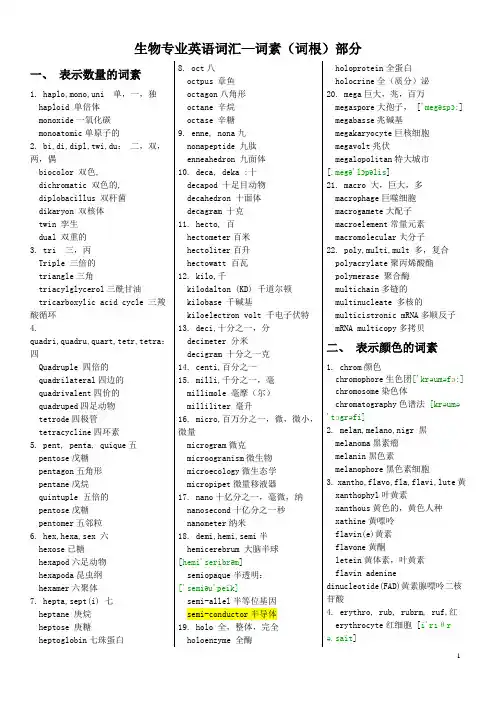
生物专业英语词汇—词素(词根)部分一、表示数量的词素1. haplo,mono,uni 单,一,独haploid 单倍体monoxide一氧化碳monoatomic单原子的2. bi,di,dipl,twi,du:二,双,两,偶biocolor 双色,dichromatic 双色的,diplobacillus 双杆菌dikaryon 双核体twin 孪生dual 双重的3. tri 三,丙Triple 三倍的triangle三角triacylglycerol三酰甘油tricarboxylic acid cycle 三羧酸循环4.quadri,quadru,quart,tetr,tetra:四Quadruple 四倍的quadrilateral四边的quadrivalent四价的quadruped四足动物tetrode四极管tetracycline四环素5. pent, penta, quique五pentose戊糖pentagon五角形pentane戊烷quintuple 五倍的pentose戊糖pentomer五邻粒6. hex,hexa,sex 六hexose已糖hexapod六足动物hexapoda昆虫纲hexamer六聚体7. hepta,sept(i) 七heptane 庚烷heptose 庚糖heptoglobin七珠蛋白8. oct八octpus 章鱼octagon八角形octane 辛烷octase 辛糖9. enne, nona九nonapeptide 九肽enneahedron 九面体10. deca, deka :十decapod 十足目动物decahedron 十面体decagram 十克11. hecto, 百hectometer百米hectoliter百升hectowatt 百瓦12. kilo,千kilodalton (KD) 千道尔顿kilobase 千碱基kiloelectron volt 千电子伏特13. deci,十分之一,分decimeter 分米decigram 十分之一克14. centi,百分之一15. milli,千分之一,毫millimole 毫摩(尔)milliliter 毫升16. micro,百万分之一,微,微小,微量microgram微克microogranism微生物microecology微生态学micropipet微量移液器17. nano十亿分之一,毫微,纳nanosecond十亿分之一秒nanometer纳米18. demi,hemi,semi半hemicerebrum 大脑半球[hemi'seribrəm]semiopaque半透明:['semiəu'peik]semi-allel半等位基因semi-conductor半导体19. holo 全,整体,完全holoenzyme 全酶holoprotein全蛋白holocrine全(质分)泌20. mega巨大,兆,百万megaspore大孢子, ['megəspɔ:]megabasse兆碱基megakaryocyte巨核细胞megavolt兆伏megalopolitan特大城市[.megə'lɔpəlis]21. macro 大,巨大,多macrophage巨噬细胞macrogamete大配子macroelement常量元素macromolecular大分子22. poly,multi,mult 多,复合polyacrylate聚丙烯酸酯polymerase 聚合酶multichain多链的multinucleate 多核的multicistronic mRNA多顺反子mRNA multicopy多拷贝二、表示颜色的词素1. chrom颜色chromophore生色团['krəuməfɔ:]chromosome染色体chromatography色谱法 [krəumə'tɔgrəfi]2. melan,melano,nigr 黑melanoma黑素瘤melanin黑色素melanophore黑色素细胞3. xantho,flavo,fla,flavi,lute黄xanthophyl叶黄素xanthous黄色的,黄色人种xathine黄嘌呤flavin(e)黄素flavone黄酮letein黄体素,叶黄素flavin adeninedinucleotide(FAD)黄素腺嘌呤二核苷酸4. erythro, rub, rubrm, ruf,红erythrocyte红细胞 [i'riθrə.sait]erythromycin红霉素erythropoitin(EPO)促红细胞生成素5. chloro,chlor绿,氯chlorophyll叶绿素['klɔrəfil] chloride氯化物chloramphenicol氯霉素6. cyan,cyano 蓝,青紫色,氰cyanophyceae 蓝藻纲cyanobacteria蓝细菌cyanide氰化物7 aur, glid, chrys金色aureomycin金霉素chrysose 金藻淀粉chrysanthemum菊花glidstone 金沙石glid 镀金8 leu,leuco,leuk,leuko,blan,alb 无色,白色leucine亮氨酸leukaemia=leucosis白血病bleaching powder漂白粉albomycin白霉素三、表示摄食的词素1 -vore 食......动物,-vorous食......动物的algivore食藻动物carnivore 食肉动物herbivore 食草动物omnivore 杂食动物2-phage吃(食)食......生物(体)-phagous吃(食)......的phage噬菌体phagocyte 吞噬细胞zoophage食肉动物saprophage腐食者四、表示方位和程度的词素1 endo,ento,内,在内endocrine内分泌endocytosis胞吞作用endogamy近亲繁殖endolysin内溶素entoderm内胚层2 ec, ect, exc, extra 外,外面,表面ectoblast外胚层ectoparasite 外寄生生物extract 抽取,浸出3 meso 中,中间mesosphere 中圈,中层mesoplast 中胚层质4 intra,intro,inter 在内,向内intra-allelic interaction 等位基因内相互作用intracellular(细)胞内的interurban城市之间5 centri,centro,medi,mid 中心,中央,中间centrifuge离心centriole 中心粒centrosome 中心体centrogeng着丝基因6 epi,peri 上,外,旁epidermal growth factor(EGF):表皮生长因子epibranchial上鳃的perilune近月点7 sub,suc,suf,sug 下,低,小suborder 亚目submucosa粘膜下层subclone亚克隆subcellular亚细胞subsection小节,分部8 super,supra 上,高,超superconductor超导体superfluid 超流体superoxide 超氧化物supramolecular超分子的9 hyper 超过,过多hypersensitive 过敏的hyperelastic 超弹性的[haipəri'læstik]hypertension 高血压hyperploid 超倍体10 hypo下,低,次hypoglycaemia 低血糖hypotension低血压hypophysis脑下垂体[haiˈpɔfisis]11 iso 等,相同,同iso-osmotic等渗的isopod等足目动物isotope同位素12 oligo,olig少,低,寡,狭oligohaline 狭盐性oligogene寡基因oligomer寡聚体oligophagous寡食性oligarchy寡头政治13 eury 多,宽,广eurythermal 广温的euryhaline广盐性eurytopic species广幅种14 ultr 超ultra-acoustics 超声学ultra-structure超微结构ultroviolet紫外线15 infra 下,低,远infralittoral 潮下带,远岸的infrahuman类人生物infrared红外线的infrastructure基础结构,基本结构五、表示动物不同器官和组织的词素1 cephal,capit,cran 头,头颅2 cyte 细胞3 carn,my,mya,myo,肉,肌肉4 haem,haemat,hem,aem,sangul 血5 soma,corp 体,身体6 some,plast 体,颗粒7 hepa,hepat 肝heparin 肝素hepatopancreas肝胰腺hepatocyte 肝细胞hepatoma肝癌8 ren,nephr 肾adrenal肾上腺的nephridia肾管nephron肾单位9 card,cord 心cardiotoxin 心脏毒素cardiovascular center 心血管中枢electrocardiogram心电图concord一致,和谐10 ophthalm,ocell,ocul 眼ophthalmology眼科学ophthalmia眼炎ophthalmologist眼科专家11 branchi 鳃filibranch丝鳃lamellibrnch瓣鳃sencondary branchium次生鳃12 brac ,brachi 腕,手臂brachiolaria 短腕幼虫brachionectin臂粘连蛋白bracelet手镯13 dent,odont 牙齿dentin牙质odontphora 齿舌odontoblast成牙质细胞14 plum羽plumatus 羽状的plumule绒毛plumage (鸟的)羽毛15 foli, foil 叶follicle滤泡foiling叶形foliage 叶子foliose 多叶的常用的后缀后缀在缀合法中只起改变词性的作用,不改变词根的含意,这在第一章内已叙述。
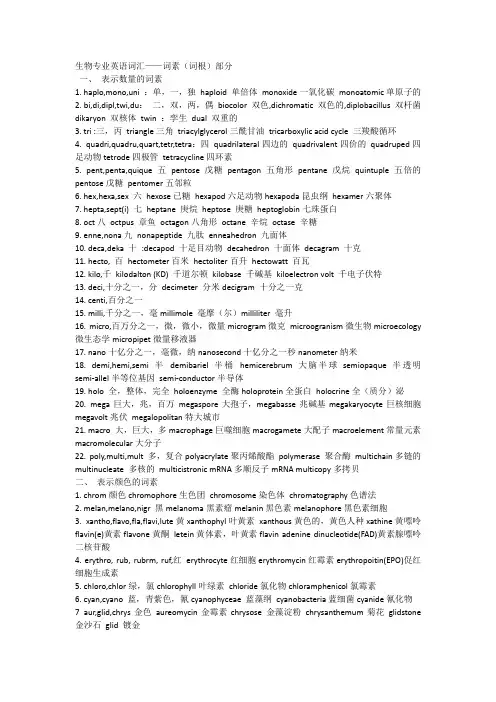
生物专业英语词汇——词素(词根)部分一、表示数量的词素1. haplo,mono,uni :单,一,独haploid 单倍体monoxide一氧化碳monoatomic单原子的2. bi,di,dipl,twi,du:二,双,两,偶biocolor 双色,dichromatic 双色的,diplobacillus 双杆菌dikaryon 双核体twin :孪生dual 双重的3. tri :三,丙triangle三角triacylglycerol三酰甘油tricarboxylic acid cycle 三羧酸循环4. quadri,quadru,quart,tetr,tetra:四quadrilateral四边的quadrivalent四价的quadruped四足动物tetrode四极管tetracycline四环素5. pent,penta,quique五pentose戊糖pentagon五角形pentane戊烷quintuple 五倍的pentose戊糖pentomer五邻粒6. hex,hexa,sex 六hexose已糖hexapod六足动物hexapoda昆虫纲hexamer六聚体7. hepta,sept(i) 七heptane 庚烷heptose 庚糖heptoglobin七珠蛋白8. oct八octpus 章鱼octagon八角形octane 辛烷octase 辛糖9. enne,nona九nonapeptide 九肽enneahedron 九面体10. deca,deka 十:decapod 十足目动物decahedron 十面体decagram 十克11. hecto, 百hectometer百米hectoliter百升hectowatt 百瓦12. kilo,千kilodalton (KD) 千道尔顿kilobase 千碱基kiloelectron volt 千电子伏特13. deci,十分之一,分decimeter 分米decigram 十分之一克14. centi,百分之一15. milli,千分之一,毫millimole 毫摩(尔)milliliter 毫升16. micro,百万分之一,微,微小,微量microgram微克microogranism微生物microecology 微生态学micropipet微量移液器17. nano十亿分之一,毫微,纳nanosecond十亿分之一秒nanometer纳米18. demi,hemi,semi半demibariel 半桶hemicerebrum 大脑半球semiopaque半透明semi-allel半等位基因semi-conductor半导体19. holo 全,整体,完全holoenzyme 全酶holoprotein全蛋白holocrine全(质分)泌20. mega巨大,兆,百万megaspore大孢子,megabasse兆碱基megakaryocyte巨核细胞megavolt兆伏megalopolitan特大城市21. macro 大,巨大,多macrophage巨噬细胞macrogamete大配子macroelement常量元素macromolecular大分子22. poly,multi,mult 多,复合polyacrylate聚丙烯酸酯polymerase 聚合酶multichain多链的multinucleate 多核的multicistronic mRNA多顺反子mRNA multicopy多拷贝二、表示颜色的词素1. chrom颜色chromophore生色团chromosome染色体chromatography色谱法2. melan,melano,nigr 黑melanoma黑素瘤melanin黑色素melanophore黑色素细胞3. xantho,flavo,fla,flavi,lute黄xanthophyl叶黄素xanthous黄色的,黄色人种xathine黄嘌呤flavin(e)黄素flavone黄酮letein黄体素,叶黄素flavin adenine dinucleotide(FAD)黄素腺嘌呤二核苷酸4. erythro, rub, rubrm, ruf,红erythrocyte红细胞erythromycin红霉素erythropoitin(EPO)促红细胞生成素5. chloro,chlor绿,氯chlorophyll叶绿素chloride氯化物chloramphenicol氯霉素6. cyan,cyano 蓝,青紫色,氰cyanophyceae 蓝藻纲cyanobacteria蓝细菌cyanide氰化物7 aur,glid,chrys金色aureomycin金霉素chrysose 金藻淀粉chrysanthemum菊花glidstone 金沙石glid 镀金8 leu,leuco,leuk,leuko,blan,alb无色,白色leucine亮氨酸leukaemia=leucosis白血病bleaching powder漂白粉albomycin白霉素三、表示摄食的词素1 -vore 食......动物,-vorous食......动物的algivore食藻动物carnivore 食肉动物herbivore 食草动物omnivore 杂食动物2-phage吃(食)食......生物(体)-phagous吃(食)......的phage噬菌体phagocyte 吞噬细胞zoophage食肉动物saprophage腐食者四、表示方位和程度的词素1 endo,ento,内,在内endocrine内分泌endocytosis胞吞作用endogamy近亲繁殖endolysin 内溶素entoderm内胚层2 ec, ect, exc, extra 外,外面,表面ectoblast外胚层ectoparasite 外寄生生物extract 抽取,浸出3 meso 中,中间mesosphere 中圈,中层mesoplast 中胚层质4 intra,intro,inter 在内,向内intra-allelic interaction 等位基因内相互作用intracellular(细)胞内的interurban城市之间5 centri,centro,medi,mid 中心,中央,中间centrifuge离心centriole 中心粒centrosome 中心体centrogeng着丝基因6 epi,peri 上,外,旁epidermal growth factor(EGF): 表皮生长因子epibranchial上鳃的perilune 近月点7 sub,suc,suf,sug 下,低,小suborder 亚目submucosa粘膜下层subclone亚克隆subcellular 亚细胞subsection小节,分部8 super,supra 上,高,超superconductor超导体superfluid 超流体superoxide 超氧化物supramolecular超分子的9 hyper 超过,过多hypersensitive 过敏的hyperelastic 超弹性的hypertension 高血压hyperploid 超倍体10 hypo下,低,次hypoglycaemia 低血糖hypotension低血压hypophysis脑下垂体11 iso 等,相同,同iso-osmotic等渗的isopod等足目动物isotope同位素12 oligo,olig少,低,寡,狭oligohaline 狭盐性oligogene寡基因oligomer寡聚体oligophagous寡食性oligarchy寡头政治13 eury 多,宽,广eurythermal 广温的euryhaline广盐性eurytopic species广幅种14 ultr 超ultra-acoustics 超声学ultra-structure超微结构ultroviolet紫外线15 infra 下,低,远infralittoral 潮下带,远岸的infrahuman类人生物infrared红外线的infrastructure基础结构,基本结构五、表示动物不同器官和组织的词素1 cephal,capit,cran 头,头颅2 cyte 细胞3 carn,my,mya,myo,肉,肌肉4 haem,haemat,hem,aem,sangul 血5 soma,corp 体,身体6 some,plast 体,颗粒7 hepa,hepat 肝heparin 肝素hepatopancreas肝胰腺hepatocyte 肝细胞hepatoma肝癌8 ren,nephr 肾adrnal肾上腺的nephridia肾管nephron肾单位9 card,cord 心cardiotoxin 心脏毒素cardiovascular center 心血管中枢electrocardiogram心电图concord一致,和谐10 ophthalm,ocell,ocul 眼ophthalmology眼科学ophthalmia眼炎ophthalmologist眼科专家11 branchi 鳃filibranch丝鳃lamellibrnch瓣鳃sencondary branchium次生鳃12 brac ,brachi 腕,手臂brachiolaria 短腕幼虫brachionectin臂粘连蛋白bracelet手镯13 dent,odont 牙齿dentin牙质odontphora 齿舌odontoblast成牙质细胞14 plum羽plumatus 羽状的plumule绒毛plumage (鸟的)羽毛15 foli,foil 叶follicle滤泡foiling叶形foliage 叶子foliose 多叶的常用的后缀后缀在缀合法中只起改变词性的作用,不改变词根的含意,这在第一章内已叙述。
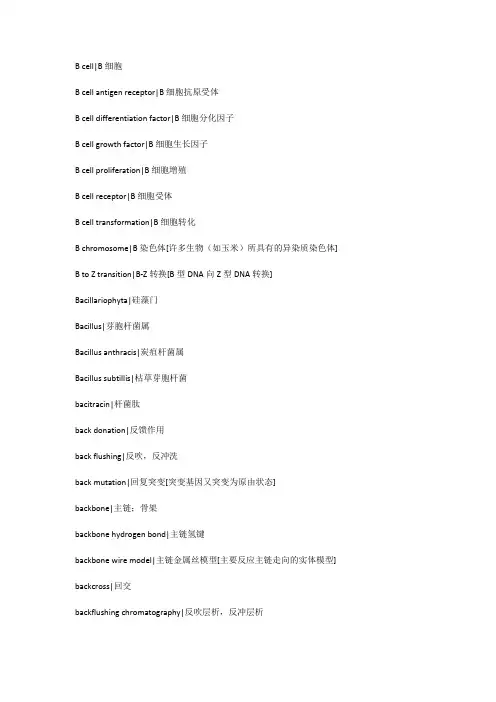
B cell|B细胞B cell antigen receptor|B细胞抗原受体B cell differentiation factor|B细胞分化因子B cell growth factor|B细胞生长因子B cell proliferation|B细胞增殖B cell receptor|B细胞受体B cell transformation|B细胞转化B chromosome|B染色体[许多生物(如玉米)所具有的异染质染色体] B to Z transition|B-Z转换[B型DNA向Z型DNA转换] Bacillariophyta|硅藻门Bacillus|芽胞杆菌属Bacillus anthracis|炭疽杆菌属Bacillus subtillis|枯草芽胞杆菌bacitracin|杆菌肽back donation|反馈作用back flushing|反吹,反冲洗back mutation|回复突变[突变基因又突变为原由状态]backbone|主链;骨架backbone hydrogen bond|主链氢键backbone wire model|主链金属丝模型[主要反应主链走向的实体模型] backcross|回交backflushing chromatography|反吹层析,反冲层析background|背景,本底background absorption|背景吸收background absorption correction|背景吸收校正background correction|背景校正background gactor|背景因子background genotype|背景基因型[与所研究的表型直接相关的基因以外的全部基因] background hybridization|背景杂交background radiation|背景辐射,本底辐射backmixing|反向混合backside attack|背面进攻backward reaction|逆向反应backwashing|反洗bacmid|杆粒[带有杆状病毒基因组的质粒,可在细菌和昆虫细胞之间穿梭] bacteremia|菌血症bacteria|(复)细菌bacteria rhodopsin|细菌视紫红质bacterial adhesion|细菌粘附bacterial alkaline phosphatase|细菌碱性磷酸酶bacterial artificial chromosome|细菌人工染色体bacterial colony|(细菌)菌落bacterial colony counter|菌落计数器bacterial conjugation|细菌接合bacterial invasion|细菌浸染bacterial motility|细菌运动性bacterial rgodopsin|细菌视紫红质,细菌紫膜质bacterial vaccine|菌苗bacterial virulence|细菌毒力bactericidal reaction|杀(细)菌反应bactericide|杀(细)菌剂bactericidin|杀(细)菌素bactericin|杀(细)菌素bacteriochlorophyll|细菌叶绿素bacteriochlorophyll protein|细菌叶绿素蛋白bacteriocide|杀(细)菌剂bacteriocin|细菌素bacteriocin typing|细菌素分型[利用细菌素对细胞进行分型] bacterioerythrin|菌红素bacteriofluorescein|细菌荧光素bacteriology|细菌学bacteriolysin|溶菌素bacteriolysis|溶菌(作用)bacteriolytic reaction|溶菌反应bacteriophaeophytin|细菌叶褐素bacteriophage arm|噬菌体臂bacteriophage conversion|噬菌体转变bacteriophage head|噬菌体头部bacteriophage surface expression system|噬菌体表面表达系统bacteriophage tail|噬菌体尾部bacteriophage typing|噬菌体分型bacteriophagology|噬菌体学bacteriopurpurin|菌紫素bacteriorhodopsin|细菌视紫红质bacteriosome|细菌小体[昆虫体内一种含有细菌的结构] bacteriostasis|抑菌(作用)bacteriostat|抑菌剂bacteriotoxin|细菌毒素bacteriotropin|亲菌素bacterium|细菌bacteroid|类菌体baculovirus|杆状病毒bag sealer|封边机baking soda|小苏打BAL 31 nuclease|BAL 31核酸酶balance|天平。


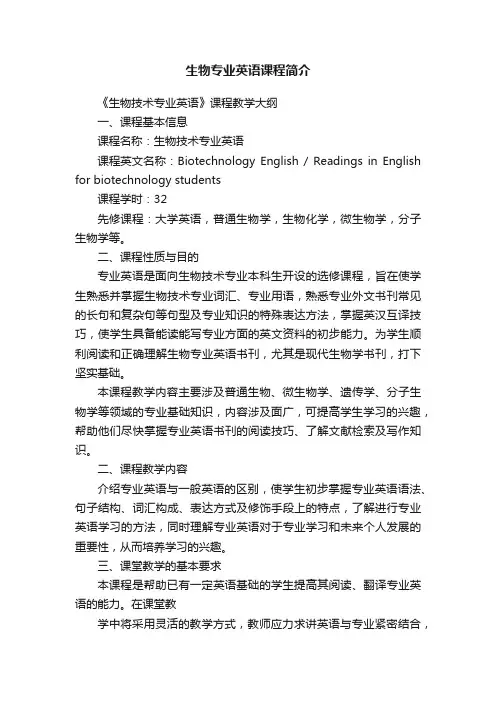
生物专业英语课程简介《生物技术专业英语》课程教学大纲一、课程基本信息课程名称:生物技术专业英语课程英文名称:Biotechnology English / Readings in English for biotechnology students课程学时:32先修课程:大学英语,普通生物学,生物化学,微生物学,分子生物学等。
二、课程性质与目的专业英语是面向生物技术专业本科生开设的选修课程,旨在使学生熟悉并掌握生物技术专业词汇、专业用语,熟悉专业外文书刊常见的长句和复杂句等句型及专业知识的特殊表达方法,掌握英汉互译技巧,使学生具备能读能写专业方面的英文资料的初步能力。
为学生顺利阅读和正确理解生物专业英语书刊,尤其是现代生物学书刊,打下坚实基础。
本课程教学内容主要涉及普通生物、微生物学、遗传学、分子生物学等领域的专业基础知识,内容涉及面广,可提高学生学习的兴趣,帮助他们尽快掌握专业英语书刊的阅读技巧、了解文献检索及写作知识。
二、课程教学内容介绍专业英语与一般英语的区别,使学生初步掌握专业英语语法、句子结构、词汇构成、表达方式及修饰手段上的特点,了解进行专业英语学习的方法,同时理解专业英语对于专业学习和未来个人发展的重要性,从而培养学习的兴趣。
三、课堂教学的基本要求本课程是帮助已有一定英语基础的学生提高其阅读、翻译专业英语的能力。
在课堂教学中将采用灵活的教学方式,教师应力求讲英语与专业紧密结合,详细讲授课程中的重点及难点部分,并要求学生在课后进行大量的阅读,以达到熟悉专业词汇、提高对专业英语的理解能力的目的。
另一方面,应启发和创造环境使学生在用英语理解问题的同时,用口语表达讲解,从而培养具有一定的听、说能力,力求在教学中体现英语学习中听、说、读、写有机的整体。
同时在整个授课过程中应贯穿讲解专业英语与日常英语在用词、修饰、语法等方面的不同之处。
课程内容的重点和深广度要求:涵盖普通生物学、生物化学、细胞生物学以及分子生物学等内容的生物学词汇,普通科技英语词汇,科技论文写作的基本规律。
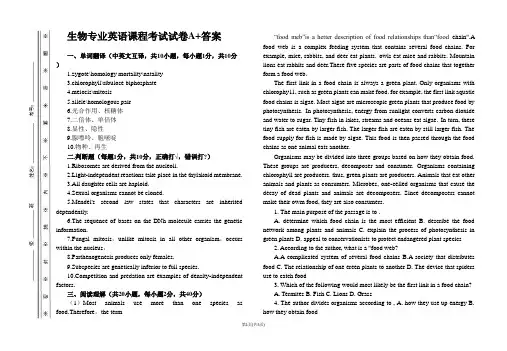
生物专业英语课程考试试卷A+答案一、单词翻译(中英文互译,共10小题,每小题1分,共10分)1.zygote\homology mortality\natality3.chlorophyll\ribulose biphosphate4.meiosis\mitosis5.allele\homologous pair6.光合作用、核糖体7.二倍体、单倍体8.显性、隐性9.腺嘌呤、胞嘧啶10.物种、再生二.判断题(每题1分,共10分,正确打√,错误打?)1.Ribosomes are derived from the nucleoli.2.Light-independent reactions take place in the thylakoid membrane.3.All daughter cells are haploid.4.Sexual organisms cannot be cloned.5.Mendel's second law states that characters are inherited dependently.6.The sequence of bases on the DNh molecule carries the genetic information.7.Fungal mitosis,unlike mitosis in all other organism,occurs within the nucleus,8.Parthenogenesis produces only females.9.Subspecies are genetically inferior to full species.petition and predation are examples of density-independent factors.三、阅读理解(共20小题,每小题2分,共40分)(1)Most animals use more than one species as food.Therefore,the term“food meb”is a hetter description of food relationships than“food chain".A food web is a complex feeding system that contains several food chains. For example, mice, rabbits, and deer eat plants. owls eat mice and rabbits. Mountain lions eat rabhits and deer.These five species are parts of food chains that together form a food web.The first link in a food chain is always a green plant. Only organisms with chlorophy11, such as green plants can make food. for example, the first link aquatic food chains is algae. Most algae are microscopic green plants that produce food by photosynthesis. In photosynthesis, energy from sunlight converts carbon dioxide and water to sugar. Tiny fish in lakes, streams and oceans eat algae. In turn, these tiny fish are eaten by larger fish. The larger fish are eaten by still larger fish. The food supply for fish is made by algae. This food is then passed through the food chains as one animal eats another.Organisms may be divided into three groups based on how they obtain food. These groups are producers, decomposer and consumer. Organisms containing chlorophyll are producers. thus, green plants are producers. Animals that eat other animals and plants as consumers. Microbes, one-celled organisms that cause the decay of dead plants and animals are decomposers. Since decomposers cannot make their owm food, they are also consumers.1. The main purpose of the passage is to .A. determine which food chain is the most efficientB. describe the food network among plants and animalsC. explain the process of photosynthesis in green plantsD. appeal to conservationists to protect endangered plant specics2. According to the author, what is a "food web?A.A complicated system of several food chainsB.A society that distributes foodC. The relationship of one ereen plants to anotherD. The device that spiders use to catch food3. Which of the following would most likely be the first link in a food chain?A. TermitesB. FishC. LionsD. Grass4. The author divides organisms according to , A. how they use up energy B. how they obtain foodC. how much energy they require in order to moveD. whether they live on the land or in the sea5. Which of the following organism could not be a consumer as described in the passage?A.a microbeB.a rabbitC.a treeD.a fish(2) Lichens can be spectacular for anyone who cares to look, but few people take the trouble. Often modestly colored and seemingly two-dimensional as they cling to whatever surface they find, they grow in the background: as though designed to be ignored. Yet they hold a special fascination for botanists, partly because they present mysteries still to be solved and partly because they do so many things so well.No casual observer of a lichen would ever suspect that it was a composite of interacting life forms. The seemingly uncomplicated lichen is actually composed of afungus and a colony of algae(or blue-green algae, which some scientists now consider to be bacteria).A few species even include all three of these diverse forms of life.A complete lichen is strikingly different from its separated partners in both appearance and biochemistry; many produce unique compounds which cannot be made by the component organisms alone.Lichens grow in almost every natural habitat imaginable, from deserts to tropical rain forests-even on the back of certain beetles in New Guinca and inside rocks(along with algae) in the otherwise barren dry valleys of Antarctica.Many species can not tolerate extreme heat, cold or dryness. Very few, however, can survive heavy air pollution, and many live only where the air is very clean. The disappearance of lichens from an area gives warning of a threatened environment.1. Which of the following would be the best title for the passage?A. The versatility and complexity of the lowly lichenB. The hidden characteristics of algae coloniesC. The disappcarance of the lichen speciesD. The habitats of spectacular fungi2. The author states that lichens grow "as though designed to be ignored"because they are A. not totally understood by botanists B. troublesome to collect for the purposes of study C. uncomplicated in their intemal structure D. not easily noticed by observers3. According to the author, most people are unaware that lichen is a.A. lcafy plantB. class of simple bacteriaC. two-dimensional life formD. Combination of organisms4. The"unique"compounds mentioned in the second paragraph are produced A. through the cooperative efforts of the lichen's parts B. only under laboratory conditions C. through one of the three possible processes D. once in the lichen's life cycle5. The author implies that lichens might be used to.A. find water sourcesB. destroy unwanted plant lifeC. test for air purityD. provide food in remote areas(3) Insects' lives are very short and they have many enemies, but they must survive long enough to breed and perpetuate their kind.The less insect like they look, the better their chance of survival.To look "inedible"by resembling or imitating plants, is a deception widely practiced by insects. Mamals rarely use this type of camouflage, but many fishes and invertebrates do.The stick caterpillar is well named. It is hardly distinguishable from a bromn or green twig. This caterpillar is quite common and can be found almost anywhere in North America. It is also called "measuring worm"of "inchworm". It walks by arching its body, then stretching out and grasping the branch withits front feet, then looping its body again to bring the hind feet forward. When danger threatens, the stick caterpillar stretchesits body away from the branch at an angle and resains rigid and still, like a twig, until the danger has passed.Walkingsticks, or stick insects, do not have to assume a rigid, twiglike pose to find protection, they look like inedible twigs in anyposition. There are many kinds of walkingsticks, ranging in sizefrom the few inches of the North American variety to some tropicalspecies that may be over a foot long. Then at rest their front legs are stretched out. Some of the tropical species are adorned with spines or ridges, imitating the thorny bushes or trees in which they live.leaves also seem to be a favorite object for insects to imitate. Many butter flies can suddenly disappear from viem by folding their wings and sitting quietly among the foliage that they resemble.6. What is the main subject of the passage?E. Catepillars that live in treesF. The feeding habits of insectsG. How some insects camouflage themselvesH. Insects that are threatened with extinction7. In lines 1, the word "enemies"refers to E. other creatures competing for space F. extreme weather conditionsG. creatures that eat insects H. inedible insects8. According to the passage, how does the stick caterpillar make itself look like a twig?E. By holding its body stiff and motionlessF. By looping itself around a stickG. By changing the color of its skinH. By laying its body flat against a branch9. Which of the following is true of stick insects?E. They resemble their surroundings all the time.F. They make themselves look like other insects.G. They are camouflaged only when walking.H. They change color to make themselves invisible.10. Which of the following are not mentioned in the passage as ob jects that are imitated as a means of protection?A. ThornsB. FlowersC. leavesD. Sticks6. In which paragraph does the author describe the way in which stick caterpillars move?A. Paragraph oneB. Paragraph twoC. Paragraph threeD. Paragraph four(4) Wide-ranging research on tooth decay has recently produced some surprising findings, one indicates that cheddar may actually inhibit the tooth-decay process. It seems to have decay-slowing effect on human teeth if it is eaten immediately after sugar. Thy cheese should have such an effect is unknown. It is speculated that the food might interfere with the acidthat decays teeth or with bacteria that produce the acid. If so, it would be the first common food found to have this useful property. The other suprprising research finding was that heavily sweetened cereals proved ahout equally potent in causing decay whether they contained eight percent,sugar or almost eight times that much.1.According to the passage,how many of the test results were unexpected?A.OneB.TroC.ThreeD.Eight2.According to the passage,what effect does cheddar cheese seem to have?E.It interferes with the function of teeth.F.It makes sugar taste sueeter.G.It decreases the rate at which teeth decay.H.It helps in the digestion of food.3.It can be inferred from the passage that the research on the relationship between cheese and tooth A.has been discredited B.will be slowed considerablyC.has been found to be conclusiveD.will be continued4.Researchers discovered that sweetened cereals were A.important nutritionally B.all surprisingly heavy in sugar C.more expensive than cheese D.all equally harmful to teeth.四、短文翻译(第1题英文短句翻译成中文,每小题2分,共20分,第2题中文翻译成英文,20分,共40分)1.英文短句翻译成中文(1)A1l eukaryotic cells contain most of the various kinds of organelles,and each organelle performs a specialized function in the cell.(2)Photosynthesis occurs only in the chlorophyl1-containing cells of green plants,algae,and certain protists and bacteria.(3)A pictorial display of an organisms chromosomes in thecoiled,condensed state is knon as a karyotype.Karyotype reveal that in most cells all but sex chromosomes are present as two copies,referred to as homologous pairs.(4)An organism that inherits identical alleles for a trait from each parent is said to be homozygous for that traits:if different alleles for a trait are inherited,the organism is heterozygous for that trait.(5)The leading strand is synthesized continuously,while the lagging strand is synthesized in short stretches known as Okazaki fragments.(6)Taxonomy reveals a great deal about the evolutionary relationshipsamong organisms.A clade is a taxonomic unit whose mesbers are derived from a common ancestor.(7)A11 fungi carry out extracellular digestion:they secrete enzymes that digest organic matter,and then they absorb the resulting nutrients.(8)The organs and tissues of the embryo arise during organogenesis,as cells inside the embryo and on its surface become specialized.(9)Populations of a species that are spread out over a broad geographical range are often arrayed in a cline-a gradual change in one or more characteristics as each population evolves adaptations to its own local environment.(10)Just as competition,predation,and other elements interact todetermine the size of a population within a comsunity,population distribution is the result of many interrelated factors.2.短文翻译(中译英)蛋白质很难说明蛋白质在生命系统中有多么重要。
生物专业英语第三版课文翻译(完整)Lesson OneInside the Living Cell: Structure andFunction of Internal Cell Parts1、 Cytoplasm: The Dynamic, Mobile Factory ( 细胞质:动力工厂 )Most of the properties we associate with life are properties of the cytoplasm. Much of the mass of a cell consists of this semifluid substance, which is bounded on the outside by the plasma membrane. Organelles are suspended within it, supported by the filamentous network of the cytoskeleton. Dissolved in the cytoplasmic fluid are nutrients, ions, soluble proteins, and other materials needed for cell functioning.生命的大部分特征表现在细胞质的特征上。
细胞质大部分由半流体物质组成,并由细胞膜(原生质膜)包被。
细胞器悬浮在其中,并由丝状的细胞骨架支撑。
细胞质中溶解了大量的营养物质,离子,可溶蛋白以及维持细胞生理需求的其它物质。
2、The Nucleus: Information Central(细胞核:信息中心)The eukaryotic cell nucleus is the largest organelle and houses the genetic material (DNA) on chromosomes. (In prokaryotes the hereditary material is found in the nucleoid.) The nucleus also contains one or two organelles-the nucleoli-that play a role in cell division. A pore-perforated sac called the nuclear envelope separates the nucleus and its contents from the cytoplasm. Small molecules can pass through the nuclear envelope, but larger molecules such as mRNA and ribosomes must enter and exit via the pores.真核细胞的细胞核是最大的细胞器,细胞核对染色体组有保护作用(原核细胞的遗传物质存在于拟核中)。
《生物专业英语》教学大纲一、课程说明1、课程简介生物专业英语是面向生物科学、技术高年级本科生开设的限选课程,本课程教学内容主要涉及普通生物、微生物学、遗传学、分子生物学等领域的专业基础知识。
通过本课程,向学生介绍如何撰写科技论文、投稿等方面的知识;扩大专业英语的词汇量,掌握专业英语书刊的阅读技巧、了解文献检索及写作知识。
2、教学目的要求本课程是帮助已有一定英语基础的学生提高其阅读、翻译专业英语的能力。
旨在拓宽学生的专业词汇量和阅读量,力求将英语与专业紧密结合,了解科技论文的文体特点和写作方法,为将来的学术论文的阅读写作和交流打下坚实的基础。
3、教学重点难点本课程重点在于向学生介绍学科专业术语和概念,进一步提高阅读、理解英语专业文献的能力;重点讲解英译汉的技巧,培养对科技文献的理解能力,使同学熟练和逐步适应书面语体的特点和表达形式,能够准确、流畅的阅读、翻译生物技术英语文献,并能熟练的掌握英语工具,获取专业所需的信息,初步具备撰写科研论文的能力。
4、预修课程与后续课程本课程的先修课为大学英语,科技论文写作可作为后续课程。
大学英语的学习使学生掌握了一定的英语词汇和语法,专业英语则是重点提高专业英语的词汇量,掌握专业英语文献的阅读技巧、了解文献检索及写作知识;是今后学术论文撰写的必需前提。
5、教学手段及教学方法建议本课程采用自学与讲授相结合,理论与实践相结合的教学方法。
教学中突出以学生作为主体,运用多媒体等教学手段对其进行专业英语的学习指导。
同时为了提高学生英语听说读写的基础能力,可采取小组讨论式等灵活多样的教学形式,调动其学习积极性。
6、考核方式本课程为考查课,期末开卷考试。
总成绩满分一百分,包括平时成绩占20%+期末考试成绩80%。
7、指定教材蒋悟生主编,生物专业英语(第二版),高等教育出版社,2000年。
8、教学参考书[1] 邬行彦等编,生物工程、生物技术专业英语(第一版),化学工业出版社,2002年。
名词解释:发酵(fermentation):通过微生物或动植物细胞生长培养和化学变化大量产生和积累专门的代谢产物的过程。
生物固定化(immobilized):将具有一定生理更能的生物细胞,如微生物细胞、植物细胞、动物细胞等,用一定方法将其固定,作为固体催化剂加以利用的一门技术,固定化细胞与固定化酶技术共同组成了现代化的生物催化技术固体培养(solid culture):微生物生长在潮湿不溶于水的基质发酵,在固体发酵过程中几乎不含自由水。
腺病毒(adenovirus):一类DNA病毒主要引起呼吸系统急性感染,经改造的的腺病毒基因组可作为基因载体用于转染,也可用于基因治疗,潜在危险性较小。
在作为基因载体转染的过程中外源基因并整合到宿主靶细胞基因组中,并且表达一定时间自然降解。
佐剂(adjuvant):能非特异性的增强机体对抗原免疫应答的物质,其本身无抗原性,但与抗原结合后可以促进机体产生抗体,或延长抗体产生的时间,还能产生炎症反应,使抗体在组织局部聚集。
胰岛素(insulin):胰腺中的胰岛β细胞分泌的一种蛋白质激素含51个氨基酸其生物学作用包括参与糖代谢、脂代谢、蛋白质代谢的调节。
单克隆抗体(monoclonal antibody):抗体主要由B细胞合成,每个B细胞有合成一种抗体的遗传基因,动物脾脏有上百万种B细胞系,含遗传基因不同的B细胞合成不同的抗体,当机体受到抗原刺激时,抗原分子上的许多决定簇分别激活各个具有不同基因的B细胞,被激活的B细胞分裂增殖形成该细胞的子代细胞,有许多个被激活B细胞的分裂增殖,形成该细胞的子代细胞,有许多个被激活的B细胞的分裂增殖形成多克隆,并合成多种抗体,若能选出一个制造一种专一抗体的细胞进行培养,就可得到由单细胞经分裂增殖而形成的细胞群即单克隆、单克隆细胞将合成一种决定簇的抗体称为Ig。
单克隆抗体技术:要制备单克隆抗体须首先获得能合成转移抗体的单克隆B细胞。
但这种B 细胞不能在体外生长,实验发现骨髓瘤细胞可在体外生长繁殖,应用细胞杂交技术使骨髓瘤细胞与免疫系统的淋巴细胞融合,得到杂交骨髓瘤细胞,这种细胞既具有B细胞合成专一抗体的特性,又具有骨髓瘤细胞能在体外培养增值永存的特性。
Ⅰ、Choose the best answers to complete each of the following sentences(2points per question, 20 points totally).For example: Complex compounds are broken down to simpler ones in______ reactions of biotechnological processes.A. Anabolic B. Catabolic C. Fermentation D. DownstreamThe best answer is B, and you should write B clearly on the line.1. Future biotechnology can also be conveniently divided into small scalebiotechnology, medium scale biotechnology and large scale biotechnology,and what will be produced in small scale?A. monoclonal antibodies and interferons B. petroleum-based technologyC. organic compounds D none of above E. all of above2. ______ in bacteria is the process by which genetic information istransferred from on cell to another by cell-to-cell contact.A. Conjugation B. Transduction C. Transformation D. Mitoticrecombination3. The microbial cell is able to reproduce itself from the very sample ofnutrients. The number of pathways which use to accomplish this is enormous:a bacteria cell probably contains well over different enzymes, and aeukaryotic cell may contain as many. Cell macromolecules of all kinds arebuilt up from about different monomer units. A general outline of thepathways of biosynthesis of these various monomers is given as ……A 1000… twice… 100 B. 1000… three times… 100A 2000…twice…200 D. 2000… three times…2004. A common method is for the organism to use , that is, for reactionthere will be distinct and independent enzymes each catalyzing the reactionwith equal efficiency.A. isoenzymes B. isomerase C. oxidoreductases D. transferase5. In the eukaryote, the cell cycle is divided into stages, each of variableduration depending on the growth conditions, the cycle culminates with thereplication of all the chromosomes which then divide between daughter andmother cell by a process known as mitosis.6. Empirically, microbial actual growth yield will depend on .A. he nature of the carbon source and the pathways of substrate catabolism;B. provision of complex substrate; C. varying efficiencies of ATP-generating reactions;D. all of the above; E. none of above7. A successful industrial culture should ultimately exhibit characteristics:it should be a pure culture; be genetically stable; be easily propagated; exhibitrapid growth characteristics; have good rate of product formation; be free oftoxic byproducts; and be amenable to genetic manipulation.A. it should be a pure culture and be genetically stable;B. have good rate of product formation;C. be free of toxic byproducts and be amenable to genetic manipulation;D. all of the above; E. just B and C8. When protoplast fusion is to be used to improve industrial strains someevents must occur:A. the generation of viable protoplasts and high fusion frequency;B. regeneration of the fused protoplasts to growing colonies in whichdiploidization and haploidization can be realized;C. all of the above; D. none of above 9. The basic design of the CSTR was develop during the 1940s and 1950swith the industrial production of penicillin.10. Future areas of improvement in solid substrate fermentations will be in A. substrate pretreatment; B. process control;C. fermenter design; D. all of the above11. What are drawbacks of whole organisms used in fermentation processes?A. optimum conditions may differ for growth and product formation;B. a high proportion of the substrates may be converted to biomass;C. wasteful side reactions may occur; the conversion rate to the desiredproduct may be slow;D. separation of the desired product from the fermentation may be difficultE. all of above; F. just B, C and D.12. Two outstanding commercial successes have been the use of in thefood and in the antibiotic industry.A. glucose isomerase…penicillin acylase B. hexokinase…terramycinC. glucose oxidase…Monoclonal antibodies D. hexokinase…monicanmycin13. What are the reasons for immobilized enzymes’ limited success so far?A. soluble enzymes used in many industrial processes are relatively cheap;B. introduction of new capital equipment to existing processes is high;C. the disappointing performance in practice of immobilized systems inrelation to overall operational economy and plant design scale;D. just A and B; E. all of above14. Over enzymes have been isolated but only have gained significantcommercial importance and most of these are hydrolases.A. 2000…20; B 2000…300; C 4000…300; D 3000…30015. is most widely and typically used to separate , and fromfermentation broths. It can also be used for yeast flocs.A. Filtration…filamentous fungi…filatmentous bacteria;B. Rotary drum vacuum filters…yeast…bacteria;C. Rotary drum vacuum filters…yeast…bacteria;D. Filtration…yeast…bacteriaAccording to the mechanism, filtration can be performed as surface filtration,or depth filtration.